Top 40 Traditional Chinese Clothing in History

Traditional Hanfu Styles Through History
Hanfu, the traditional clothing of the Han Chinese, has evolved over thousands of years, leading to hundreds of different styles. Throughout history, traditional Hanfu styles have undergone numerous transformations, each reflecting the cultural and social changes of their time. Today, we’ll dive into some of the most iconic and classic styles of Hanfu, focusing especially on those that have left a lasting impression in Chinese fashion history. These traditional Hanfu styles through history offer a glimpse into the beauty and significance of Chinese clothing traditions, showcasing how each style represents its era.
Yichang (衣裳, Upper Garment, Lower Garment)
Also known as Shangyi Xiachang (Upper Garment, Lower Garment), this is one of the earliest clothing styles in China and the first form in the Hanfu system, emerging around the Shang Dynasty. The upper garment features a cross-collar with a right-over-left closure, while the lower garment is a one-piece wraparound skirt, both secured with knotted sashes. This design is the most fundamental characteristic of Hanfu.
After the Qin and Han Dynasties, men’s Shenyi (one-piece robe) style gradually replaced Yichang. The Yichang style became primarily used as ceremonial attire and, in later periods, evolved into the most formal and solemn ceremonial dress for men.

Ruqun (襦裙, Jacket and Skirt)
The Ruqun, also known as the Shanqun (衫裙), is one of the most representative forms of Hanfu for women. It consists of two main parts: the ru (襦), which is a short top, and the qun (裙), a long skirt. Together, they form the Ruqun, a style that embodies the “upper garment, lower skirt” concept.
One distinctive feature of the Ruqun is that the top is short, and the skirt is long. The Ruqun can be traced back to the Warring States period, but it only became common among regular women during the late Ming and early Qing dynasties.
-图片描述-1.png)
Jiaoling Ruqun (交领襦裙, Cross-Collar Jacket and Skirt) or Shanqun (衫裙)
A variation of the Ruqun is the Jiaoling Ruqun. Its defining feature is the cross-collared top, which was quite popular during the Song dynasty.
How to wear it:
- First, put on the top part of the outfit and align the collar.
- Tie the right side of the collar.
- Tie the left side of the collar.
- Next, wear the skirt. Wrap it around your waist and pull it up behind.
- Adjust the inner lining and fold it out to display.
- Tighten the skirt and adjust the length as needed.
For more detailed dressing steps, check out: How To Wear Hanfu Cross-Collar Ruqun
-1-1024x1024.png)
Dui Jin Ruqun (对襟襦裙, Open-Front Jacket and Skirt)
The Dui Jin Ruqun is another variation where the skirt waistband aligns with the waist, and the collar is symmetrical in design.
For more detailed dressing steps, check out: How To Wear Hanfu Dui Jin Ruqun

Qixiong Ruqun (齐胸襦裙, Chest-High Jacket and Skirt)
The Qixiong Ruqun is a traditional style that originated in the Sui and Tang dynasties. It features a high-waisted skirt and is tied just under the armpits.
For more detailed dressing steps, check out: How To Wear Hanfu Qixiong Ruqun

Tanling Ruqun (坦领襦裙, U-Neck Jacket and Skirt)
The Tanling Ruqun, also known as the “U-neck Ruqun,” originated in the Sui dynasty as court attire. It evolved into a style that was popular in the Tang dynasty and later spread to the general population. The defining feature is a heart-shaped neckline, which often leaves the chest area exposed.

Shenyi (深衣, One-Piece Robe)
The Shenyi is a one-piece outfit where the top and skirt are sewn together. This style gives off a dignified and elegant look. Shenyi can be further categorized into Zhiju (直裾) and Quju (曲裾).
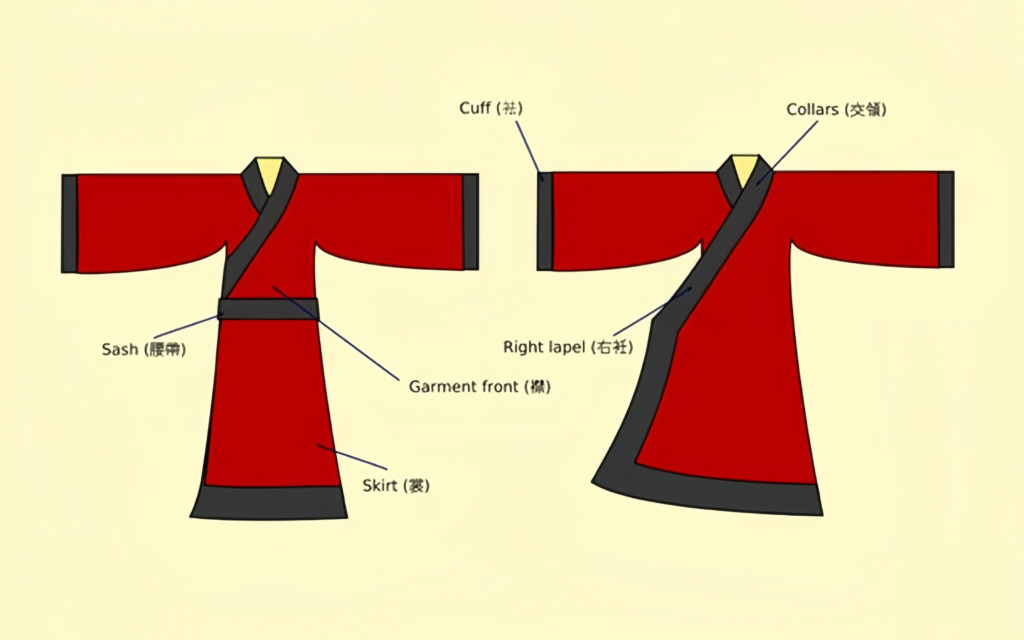
Zhiju (直裾, Straight-Hem Robe)
Zhiju (直裾) has been around since the Western Han dynasty and is known for being simple and practical but not usually formal enough for ceremonial occasions.
-图片描述-1-1024x1024.png)
Quju (曲裾, Curved-Hem Robe)
Quju (曲裾) became more popular in the Qin and Han dynasties. This style is tight-fitting at the top with a flared skirt. The collar is usually low, revealing layers of undergarments beneath, while the sleeves could be wide or narrow.

Beizi (褙子, Long Jacket)
The Beizi is a long-sleeved coat that falls just above the knee and doesn’t have seams at the underarms. It is worn on top of other layers, with a collar that runs from top to bottom.
-图片描述-1-1024x1024.png)
Aoqun (袄裙, Coat and Skirt)
The Aoqun refers to an outer coat paired with a long skirt. The coat is usually lined for warmth and is often worn in colder weather, with the skirts being quite varied, with MaMian skirts being the most common. The Aoqun became popular during the Ming dynasty.
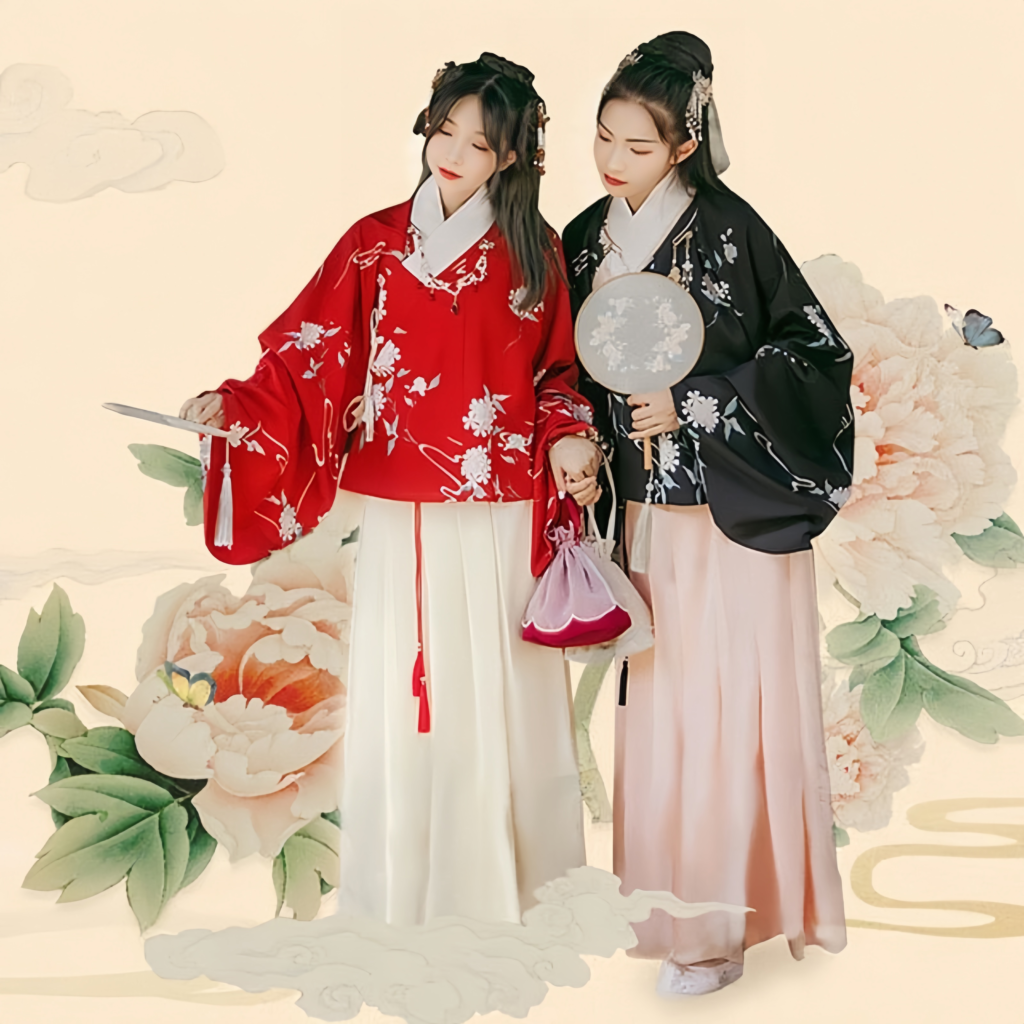
YuanlingPao (圆领袍, Round Collar Robe)
The Round Collar Robe is a long robe with a rounded neckline. The collar does not fully cover the neck, and a button or knot is typically used to close it. This style has become a symbol of official attire in modern times.
-图片描述-1-1024x1024.png)
Banbi (半臂, Half-Sleeve Shirt)
The Banbi, or “Half Sleeve,” is a short-sleeved shirt that extends to the elbows, with a length that reaches the waist. It can be worn alone or layered under other pieces of Hanfu.

Bijia (比甲, Sleeveless Outer Garment)
A Ming Dynasty unisex sleeveless outer garment, a type of half-sleeve (Banbi). Available in long or short lengths, it’s worn over shirts or jackets to protect inner layers and add visual depth.

Ru (襦) / Shan (衫) / Ao (袄)
- Ru: A short top that usually ends at the waist. Common in the Han dynasty, where the “upper Ru, lower skirt” style was popular.
- Shan: A form of tunic that’s close-fitting and typically worn under outer garments.
- Ao: A longer outer garment, often worn over the Ru or Shan.

Pifeng (披风, Cloak)
The Pifeng, or cloak, is a large piece of outerwear that is usually worn over other clothes. It typically features a straight collar and can be either open or tied at the neck. The style was particularly popular during the Ming dynasty.
-图片描述-1-1024x1024.png)
Daxiu (大袖衫, Wide-Sleeved Shirt)
During the Tang dynasty, women’s clothing became increasingly expansive. The Daxiu features extremely wide sleeves, often more than four feet in length. The material is light, making it suitable for warm weather or indoor wear.

Mamian Skirt (马面裙, Horse-Face Skirt)
The Mamian Skirt is a type of pleated skirt with a smooth panel in the front, and pleats on the sides. It was commonly worn during the Ming dynasty and remains a symbol of traditional feminine attire.

Guiyi (袿衣, Ceremonial Curved-Hem Robe)
A high-status women’s ceremonial robe, a variation of the Quju Shenyi. Prominent in the Wei-Jin period, it evolved into a separate top-and-skirt structure by the Southern and Northern Dynasties.
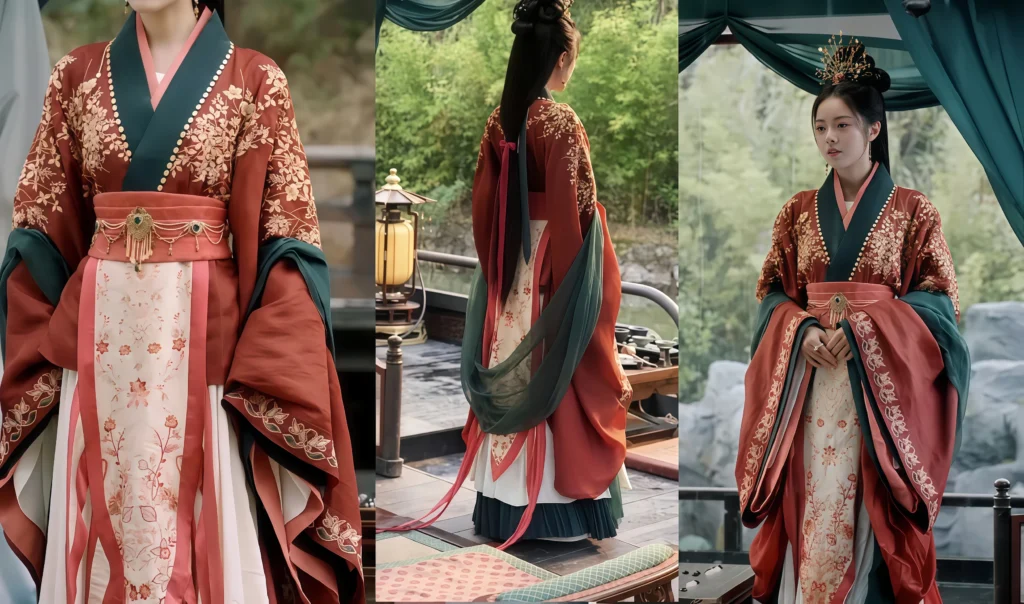
Baidiqun (百迭裙, Hundred-Pleat Skirt)
A one-piece skirt with dense pleats across the middle and smooth panels (qunmen) at the front. Unlike the Ma Mian skirt, which has pleats only on the sides and smooth panels front and back, the Baidiqun has a front-facing smooth panel, making it distinct.
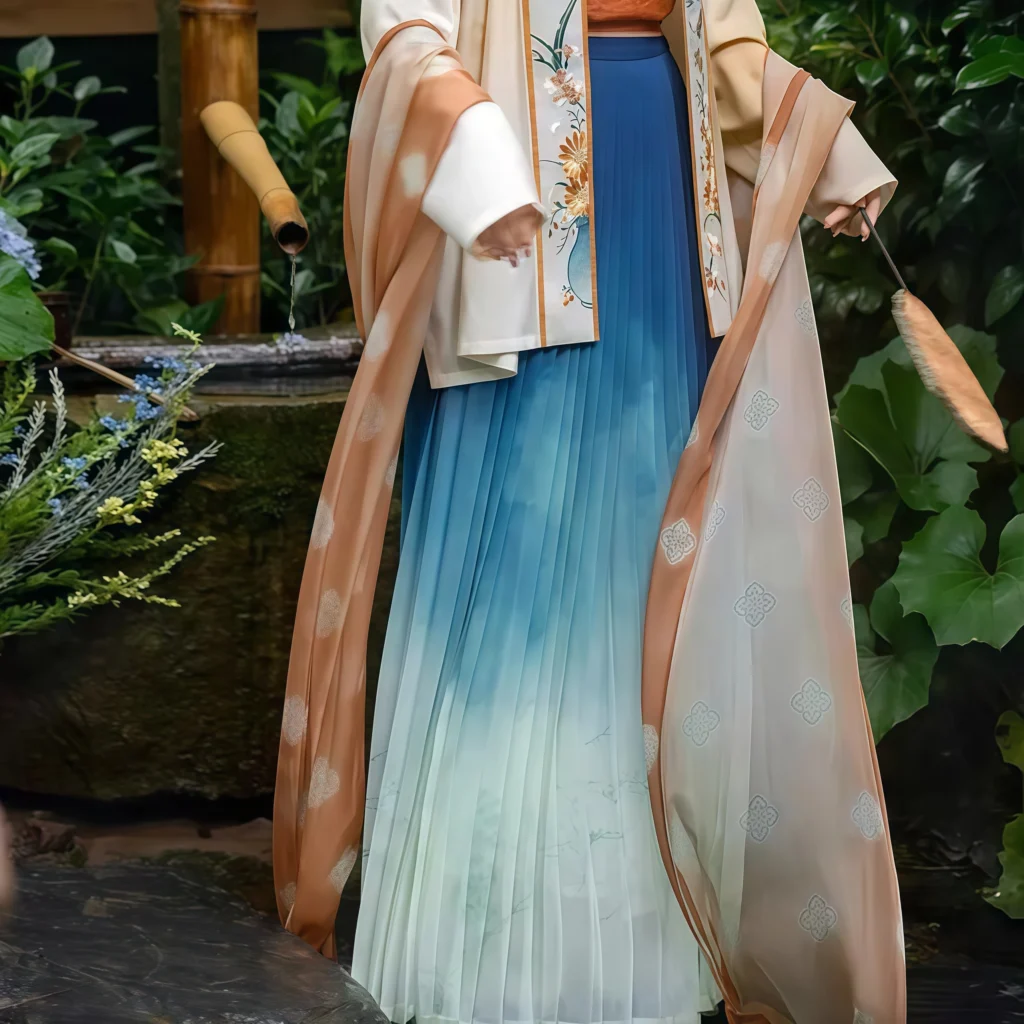
Liangpianqun (两片裙, Two-Piece Skirt)
A two-piece skirt with an outer and inner panel sharing a single waistband. The panels are separate at the body, creating a straight or slightly flared silhouette. Some scholars believe this is the “spinning skirt” (xuánqún) from historical texts, popular across social classes for its practicality in daily life and travel.
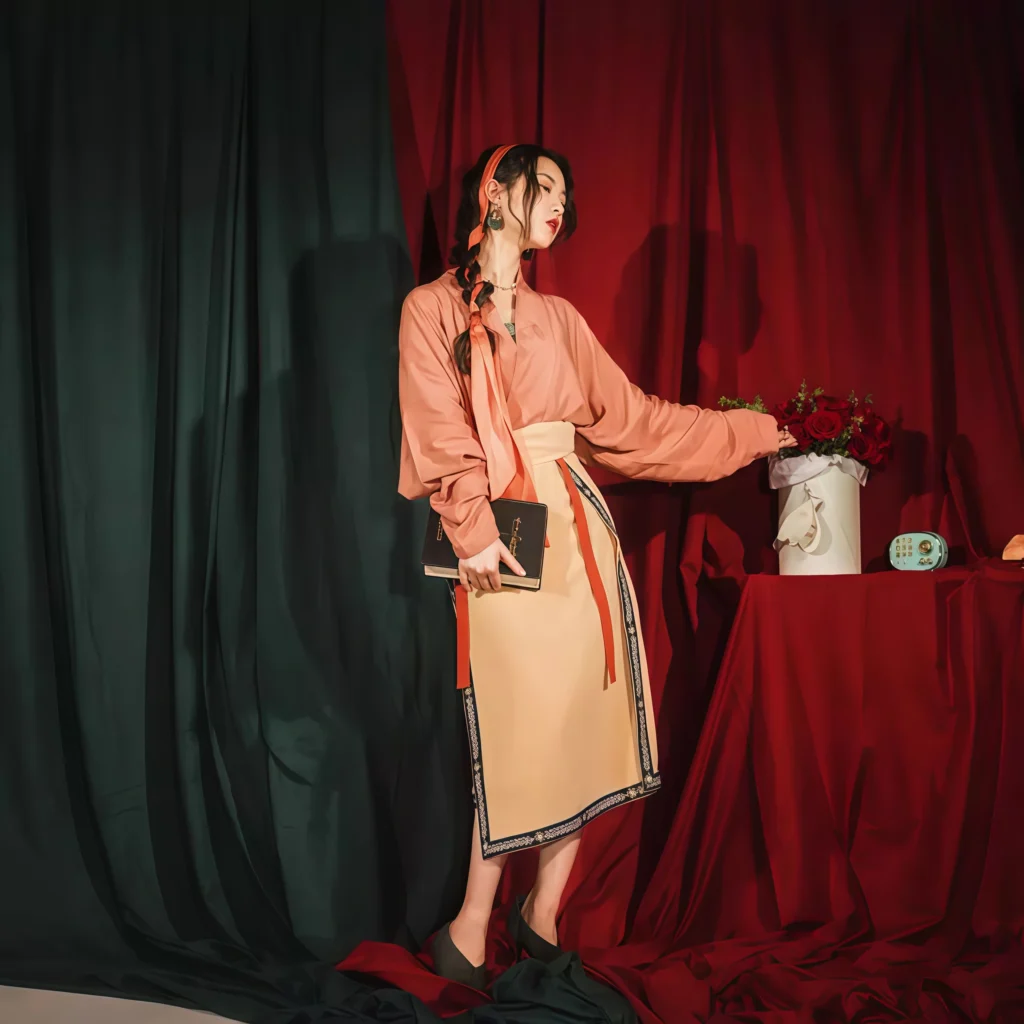
Songku (宋裤, Song Trousers)
While skirts dominated women’s Hanfu, trousers were also worn, especially in the Song Dynasty. Songku consists of two layers: an inner open-crotch layer and an outer layer with side slits, ankle-length, and uniformly wide, sometimes with embroidered cuffs, giving a flowing, ethereal look when walking.
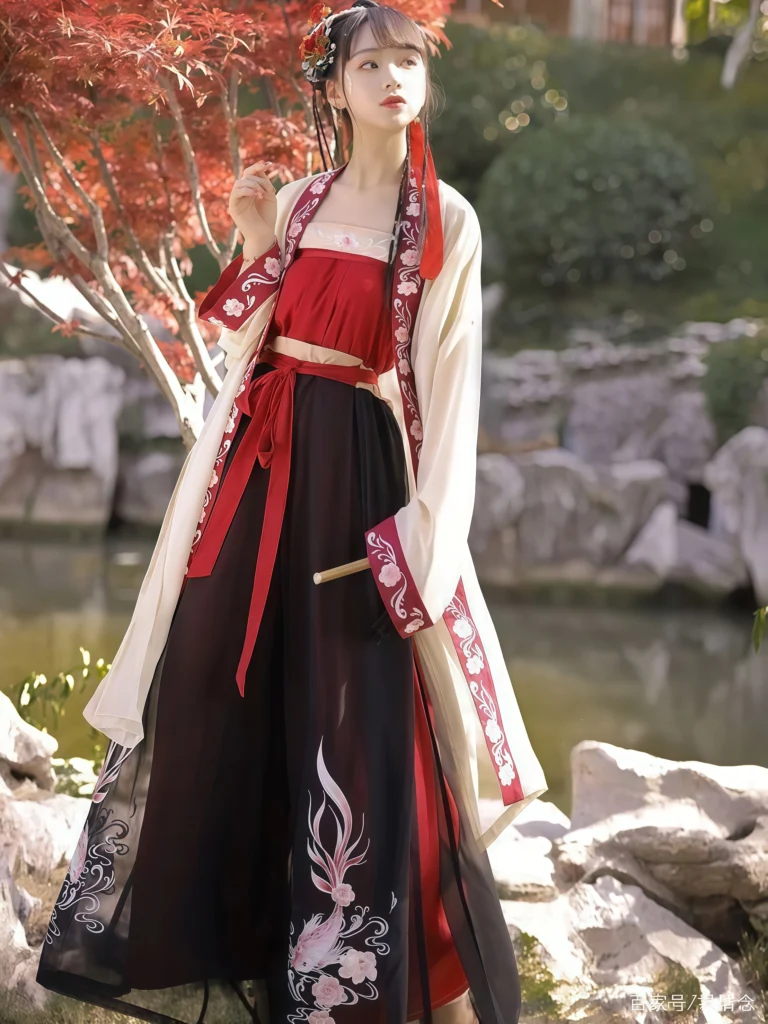
Danyi (襌衣, Single-Layer Outer Garment)
A single-layer outer garment, often lightweight, worn over robes, as opposed to padded garments (fuyi). Not a specific style but a layering concept, Danyi can be straight-hem (Zhiju) or curved-hem (Quju). It adds decoration and depth, reflecting the ancient aesthetic of “brocade hidden under plain cloth” for modesty and subtle beauty. Example: Mawangdui plain silk Danyi (weighing 49 grams).
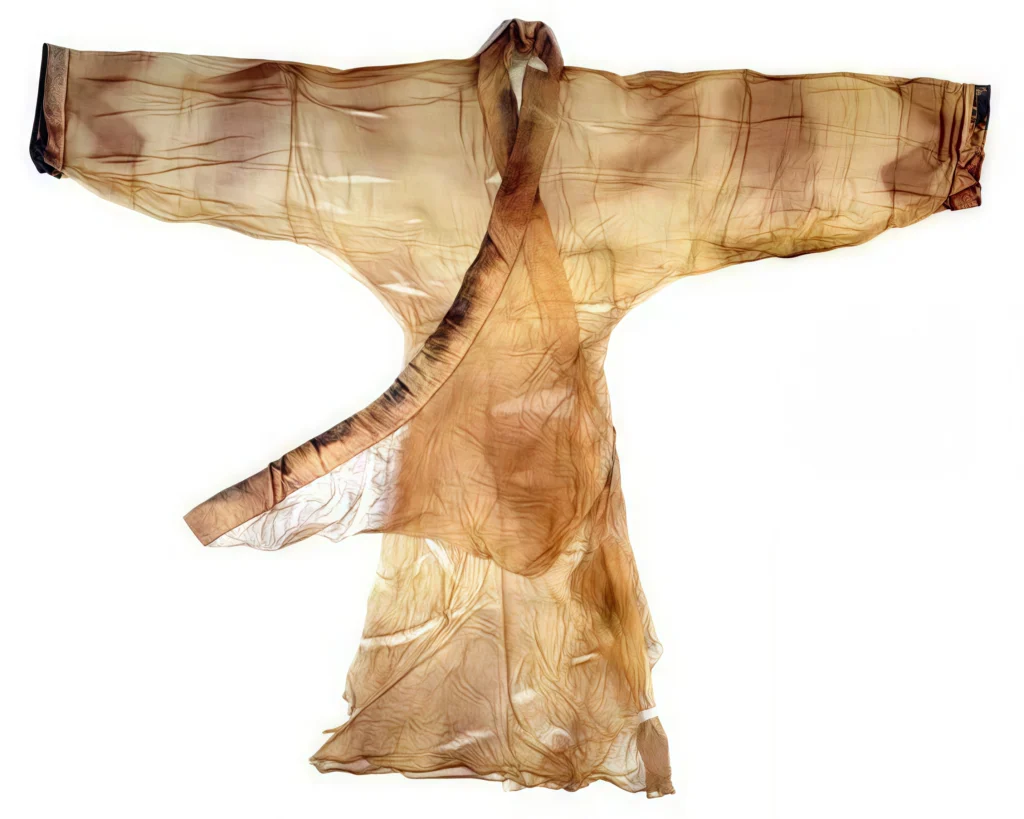
Zhiduo (直裰, Cross-Collar Long Shirt)
A men’s garment, essentially a cross-collar long shirt popular across dynasties. It features a cross-collar, straps, and side slits, made with a single-piece cut, suitable for both daily and formal settings.
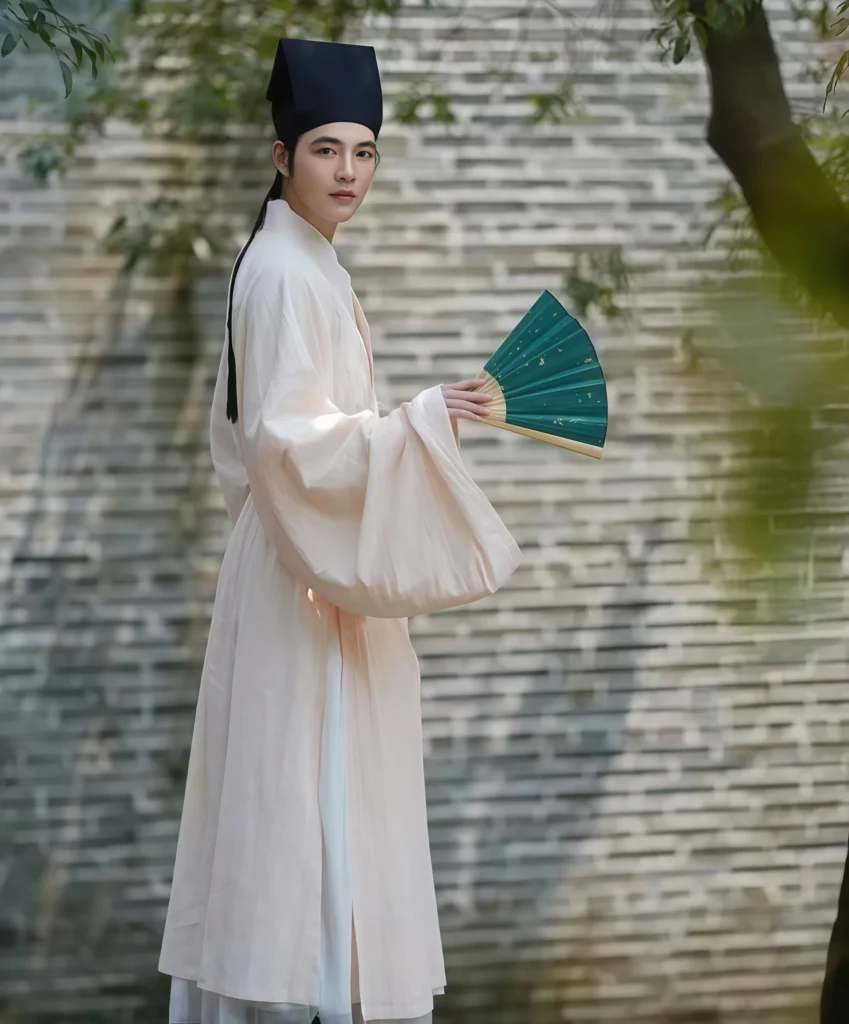
Zhishen (直身, Single-Piece Long Robe)
A men’s single-piece long robe with a cross-collar, straps, side slits, and outer flaps. Its wide sleeves and belted waist make it versatile for various occasions.
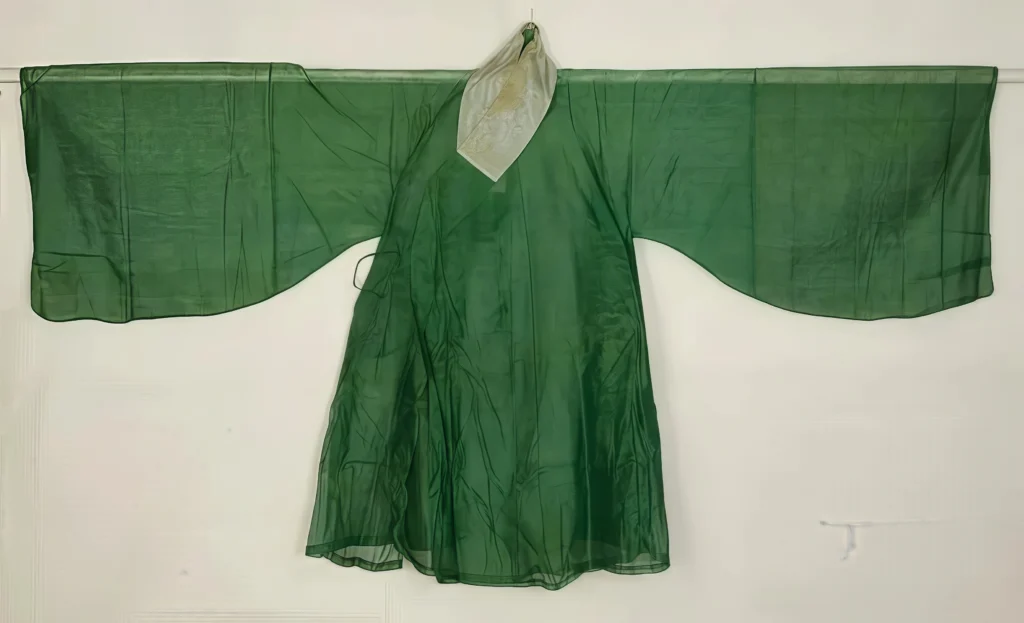
Lanshan (襕衫, Scholar’s Robe)
The Lánshān is a special version of the Shenyi that reaches just to the knee and is often worn by scholars.
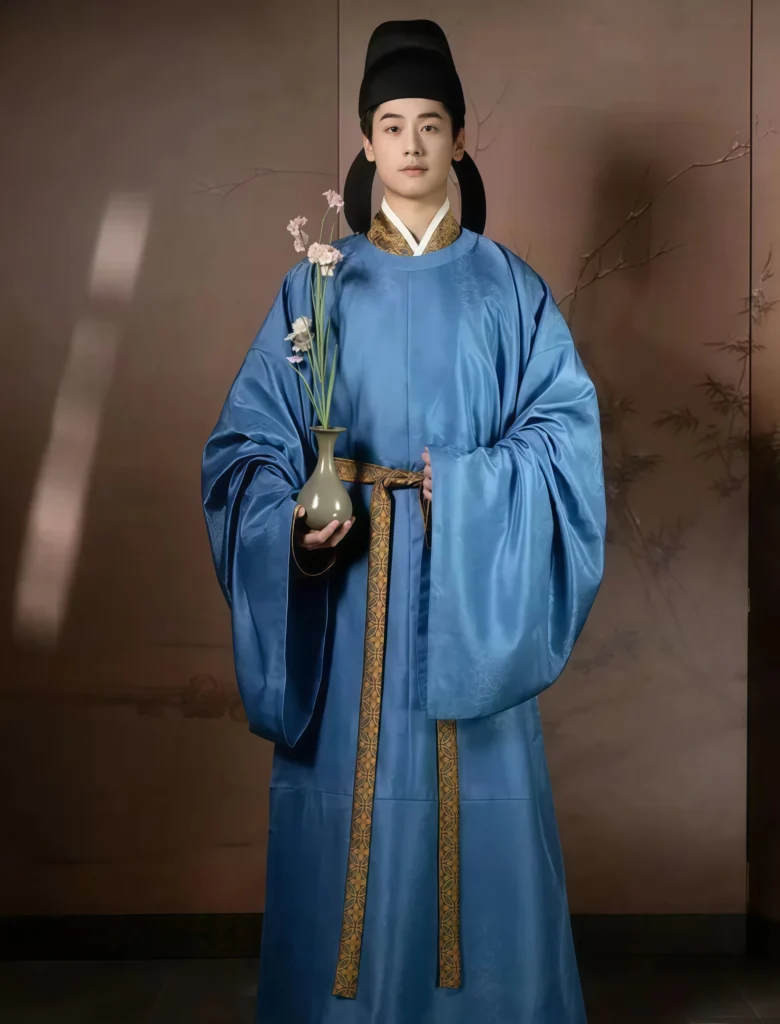
Pao (袍, Robe)
The Pao is a long robe that is very common in traditional Chinese attire. It is typically worn by men in formal settings and is similar to the Round Collar Robe but often longer and more elaborate.
-服装细节-1-1024x1024.png)
Daopao (道袍, Taoist Robe)
The Daopao, or Taoist robe, is a loose-fitting robe that is typically worn by Taoist priests. It features a straight collar and is often worn by practitioners of Taoism.

Yisan (曳撒, Mongolian-Style Robe)
Yisan is a traditional Mongolian garment that was incorporated into the Ming dynasty’s Hanfu styles. It has wide sleeves and a pleated skirt and was originally worn by nomadic herders.
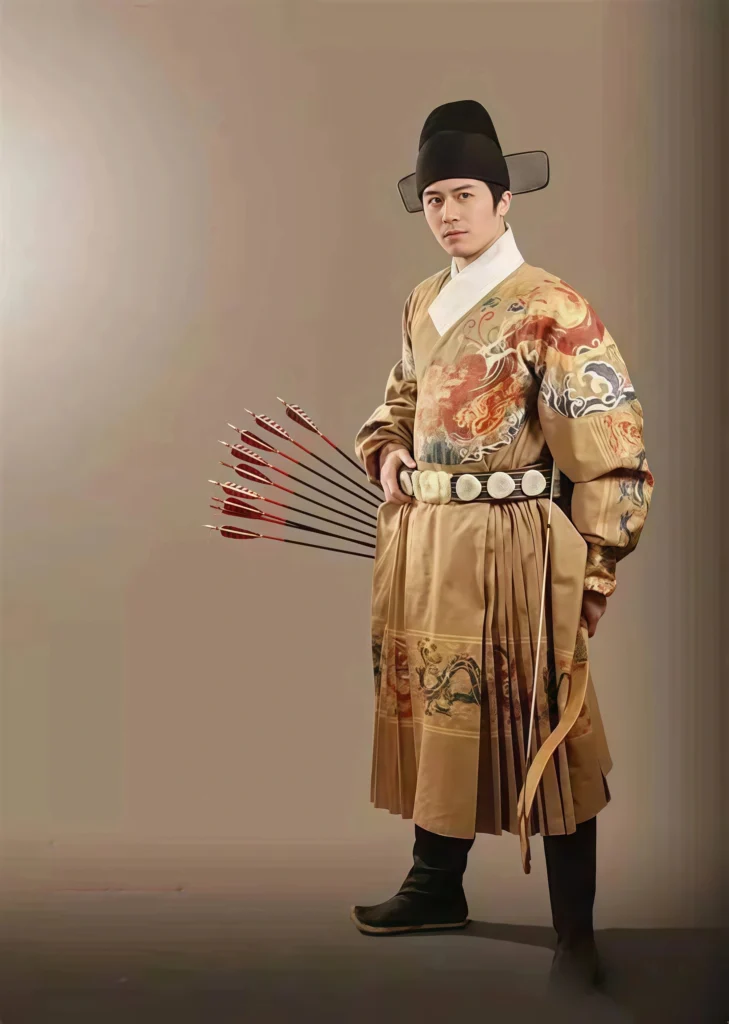
Tieli (贴里, Pleated One-Piece Robe)
A pleated robe in the Shenyi style, connecting top and bottom. It extends past the knees, sometimes to the ankles, with a cross-collar, right-over-left design, and optional protective collar. The lower part consists of two fully pleated panels, with no side slits or outer flaps, suitable for both men and women. Typically worn as a base layer but can be outerwear.
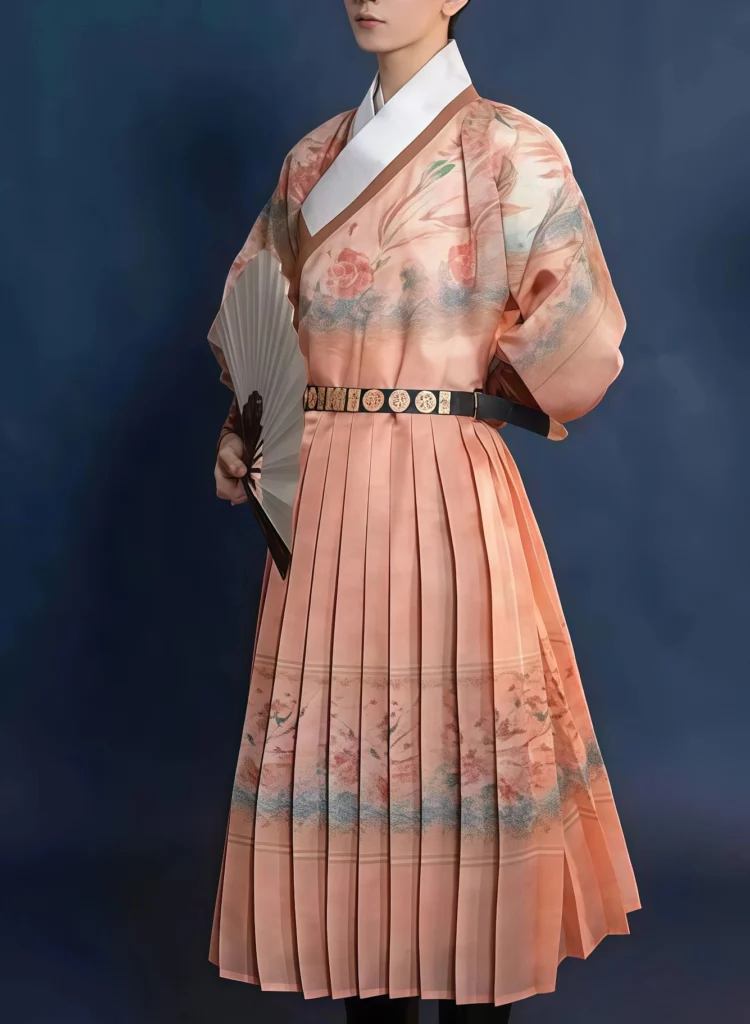
Zhaojia (罩甲, Sleeveless Military Vest)
A sleeveless or short-sleeved open-front outer garment with a military-inspired design, used by both civilians and soldiers. It features a square collar with buttons, exuding a strong, practical vibe, with side slits for flexibility and comfort during movement.
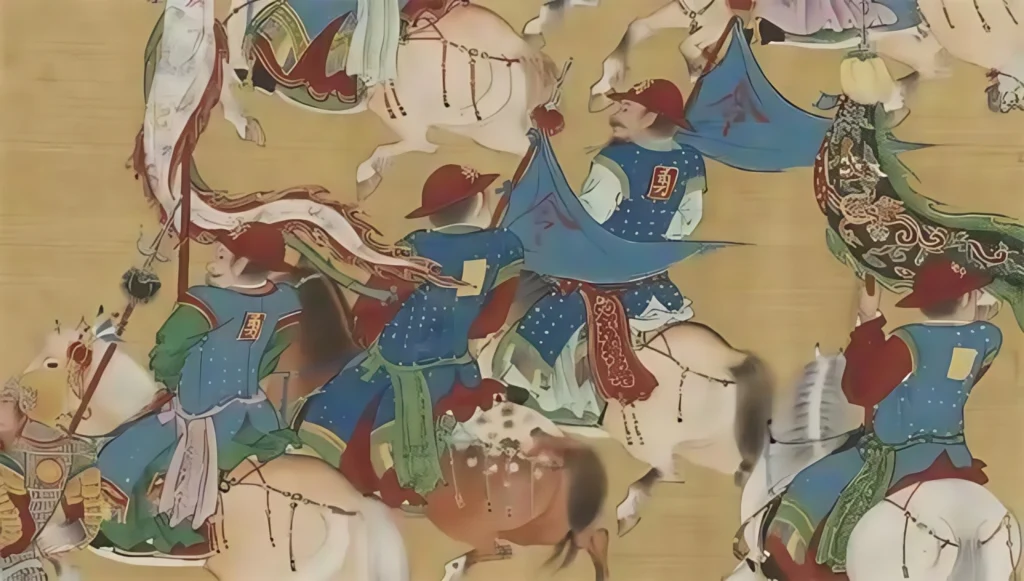
Dachang (大氅, Ceremonial Robe)
A ceremonial robe with a straight collar, worn over cross-collar shirts, extending past the knees or to the ankles. Its collar and hems are often black, adding solemn elegance. Paired with skirts or trousers, it forms a complete formal look.
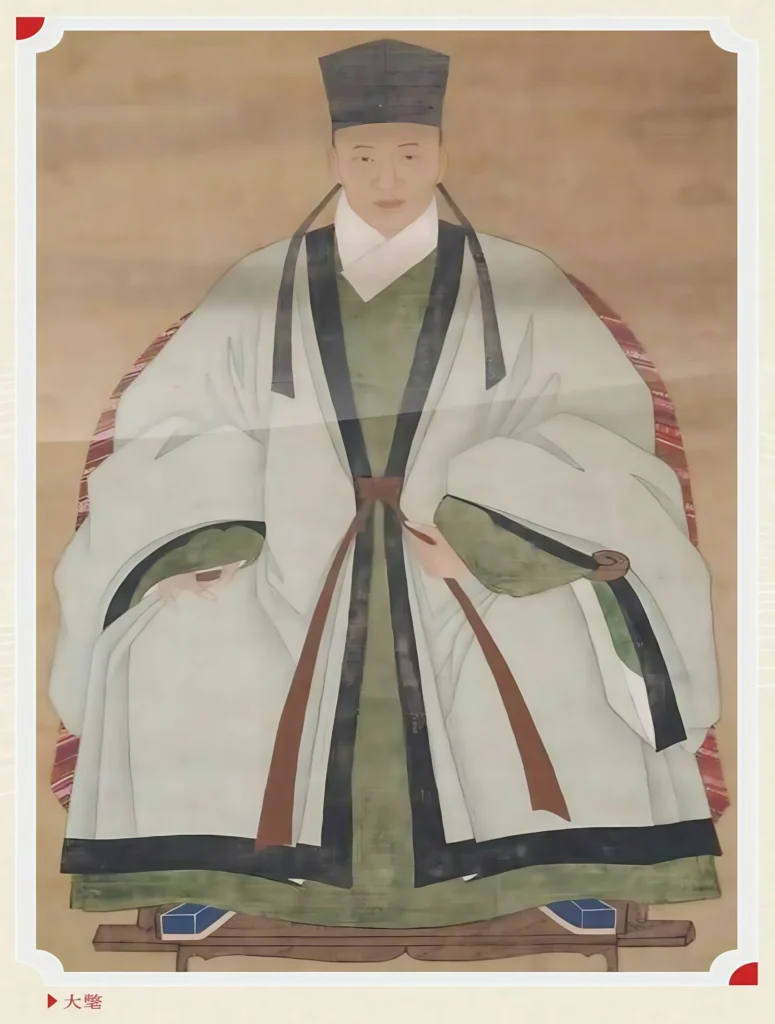
Feiyufu (飞鱼服, Flying Fish Robe)
A Ming Dynasty exclusive garment bestowed by the emperor to trusted allies as a mark of honor. Adorned with flying fish motifs (resembling python patterns with two horns, fins, and a tail), it’s identical on both sides.
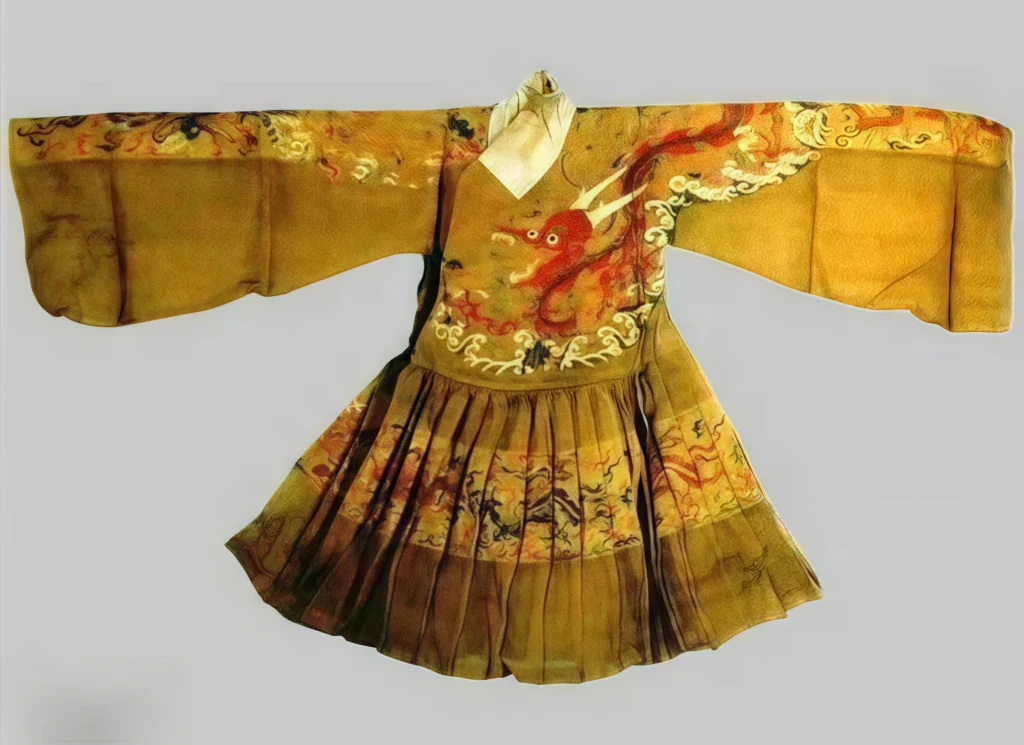
Dahu (褡护, Long Half-Sleeve Garment)
A long half-sleeve garment, cut as a single piece, reaching the ankles. It features a cross-collar, right-over-left design, optional protective collar, and side slits. With outer flaps, it’s worn as outerwear; with inner flaps, it’s a base layer paired with garments like Zhishen, Round Collar Robe, or Daopao. A casual style for daily wear.
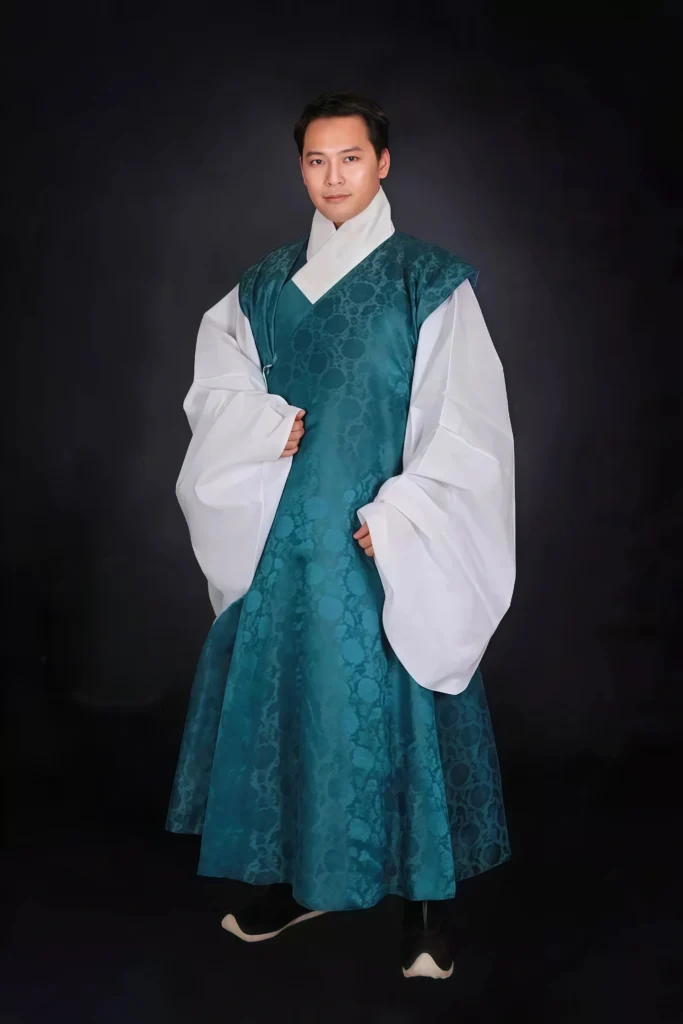
Duanhe (短褐, Coarse Labor Attire)
A practical Hanfu style, also called “vertical brown” or “coarse brown,” designed for labor and distinguished from formal or ceremonial attire.
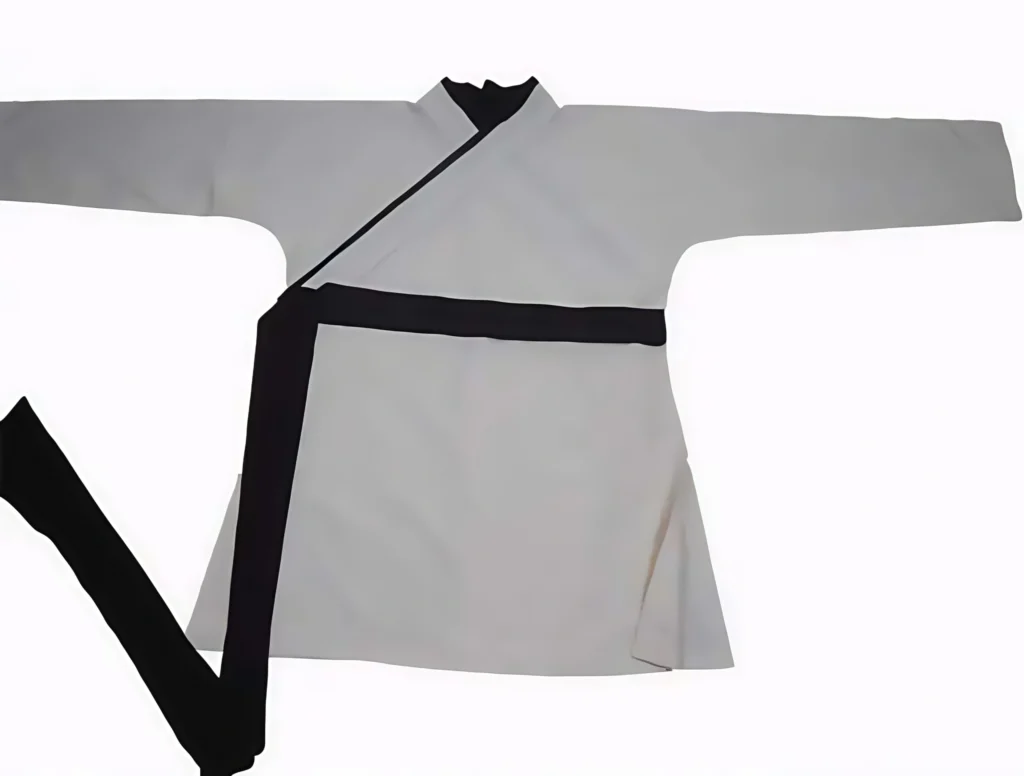
Tieyi (铁衣, Iron Clothing)
Tieyi, meaning “Iron Clothing,” was a form of heavy coat popular in the Ming dynasty. It was a practical piece of clothing designed for stability and formality.
Hufa (护法, Short Robe)
The Hufa is a traditional Chinese short robe. It has a loose fit and is commonly worn for casual occasions.
Qipao (旗袍, Cheongsam)
Qipao, also known as Cheongsam, emerged much later in the early 20th century, during the 1920s. It quickly became the most popular female attire of the time and remains a symbol of modern Chinese femininity. The origins of this iconic garment are still debated, with some suggesting it developed from the long robes worn during the Qing Dynasty, while others trace it back to earlier periods, such as the Zhou or Han dynasties. In some circles, the Qipao is also viewed as a Westernized version of traditional Chinese dress.
The biggest controversy is whether the qipao counts as Hanfu. Some argue, based on history, that the qipao evolved from Manchu clothing and isn’t part of Han Chinese dress heritage. Others believe the qipao, originating from Chinese dynasties and passed down by Han people, qualifies as Hanfu. Some also compare the qipao’s design to traditional Hanfu styles, highlighting their many differences.
The qipao is widely used in modern times, possibly because everyday Hanfu can be cumbersome to wear, while the qipao is more practical for daily use. Additionally, the qipao appears frequently in contemporary Chinese-style weddings.
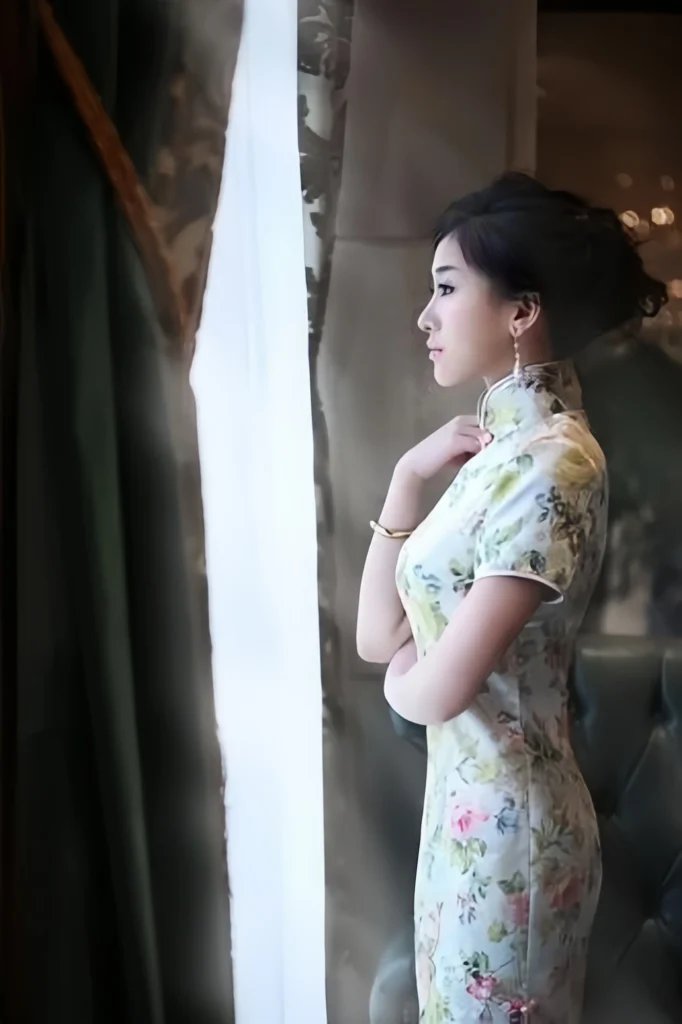
Hanfu is a diverse and rich tradition, encompassing many different styles for both men and women. Each piece represents not only aesthetic beauty but also deep cultural significance. From the layered elegance of the Ruqun to the stately Shenyi, these garments showcase the evolution of traditional Hanfu styles through history. Every style tells a unique story, reflecting China’s long history and its cultural heritage. Hanfu continues to influence modern fashion, preserving ancient artistry while adapting to contemporary trends. Through its intricate designs and timeless elegance, Hanfu offers a glimpse into the past, keeping the spirit of ancient Chinese culture alive.
To further explore the rich history and wearing techniques of Hanfu, check out these resources for more detailed insights:
Discover the Rich Culture of Hanfu: Traditional Chinese Clothing


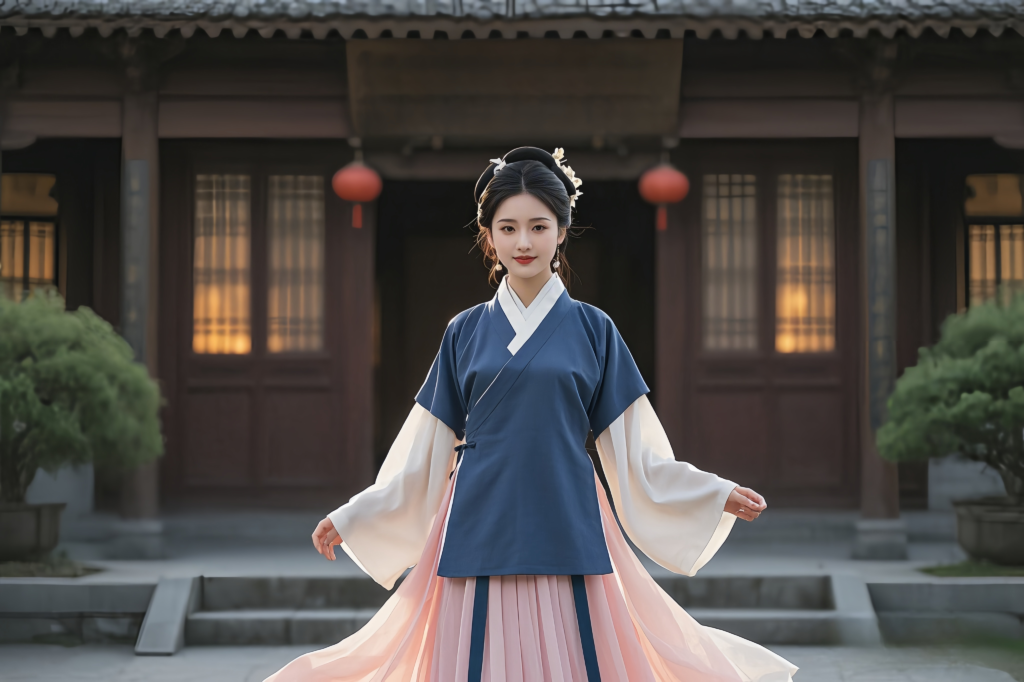


[…] Traditional Chinese Hanfu doesn’t mean “Han Dynasty clothing”—it’s a broad term for the traditional ethnic dress of China’s Han people, one of the world’s oldest ancient Chinese clothing styles.Overseas, folks often admire the elegance of Korean Hanbok or the graceful beauty of Japanese Kimono, but many Chinese don’t realize Hanbok is just a Ming-era Han ritual outfit, and Kimono borrows from a few Tang Hanfu clothing styles. […]
[…] down the street, people around you can’t figure out your Hanfu clothing type—help them out with pics and this guide! This overview introduces the most common Hanfu styles, […]